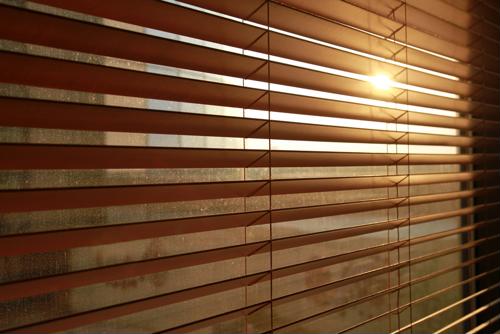
The right drapes or blinds can do more than bring a room together visually. They can also be a great way keep your home at a comfortable temperature throughout the year. With a little planning and know-how, your window treatments can help you keep cool in summer and warm in winter, and they can do it all while still looking stylish.
Controlling light controls heat
One of the main functions of any type of window treatment is to regulate the amount of light - and therefore heat - entering a room. This means that knowing when to keep your windows covered or uncovered is one of the simplest ways to influence the temperature. In summer, keep all blinds closed or curtains drawn during the daytime. In winter, on the other hand, you should leave any windows uncovered that receive direct sunlight. During the day, cover only the ones that don't face the sun. At night, cover all of them in order to keep as much heat inside as possible.
However, that's only scratching the surface. Different types of treatments work better than others, and some are more suited to one season or another. Cellular window shades are specifically mentioned by the Department of Energy as a good choice for either season. Their design creates pockets that trap air, keeping warm air inside in winter and cool air in summer, adding an extra layer of insulation around your windows. Pleated shades work in much the same way.
Also, keep in mind that controlling light doesn't mean that you need to block it out entirely. While blackout curtains are a popular and energy-efficient choice, they're not the only option. Sheer shades provide great flexibility, allowing you to leave them open for soft, filtered light, or close them to keep out more of the sun's rays.
Materials matter
Most window treatments are available in a wide variety of designs, patterns, and even textures, with materials ranging from silk to bamboo to plastic. One consideration that should not be overlooked is color. Keep in mind that lighter colors tend to reflect light, which makes them most effective in warm weather, while darker colors absorb and retain heat. This doesn't mean that you need to choose between white and black, however. Draperies in a medium tone of any color are a good choice for both winter and summer.
You can also take advantage of the colors in the interior of your house. Although blinds don't provide a whole lot of light control - there are too many little gaps between the slats - they do allow you to direct that light with a great amount of precision. If you have a light-colored ceiling, angle the blinds upwards in summer so that incoming light hits the ceiling instead of the walls or floor. The pale color will scatter light and keep things a little cooler indoors.
Reflective materials, such as shiny plastic or beautifully stained wood blinds, can also help ward off heat. Fabric drapes, on the other hand, can be very effective in preventing heat loss, although this varies depending on the weave and weight of the fabric. The way they hang also allows air to circulate in the folds, keeping things a bit cooler in summer. Some treatments, such as roman window shades, are available in both hard and soft varieties.
Combine treatments for added efficiency
Overlapping different treatments can blend the benefits of hard and soft materials and give your insulation an added boost. This can be as simple as ensuring that the edges of drapes overlap each other when they hang. You can also use exterior shutters together with interior drapes or shades, or get drapes with plastic backing.
Any treatment can also be used alongside reflective glass or film, although these work best in summer as opposed to winter, and the film may reduce the visibility of the glass.

